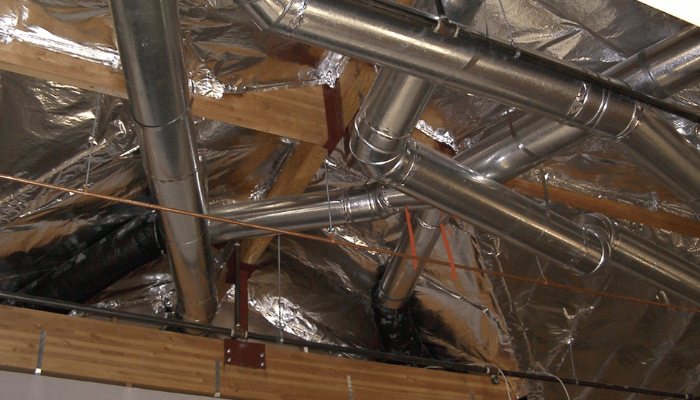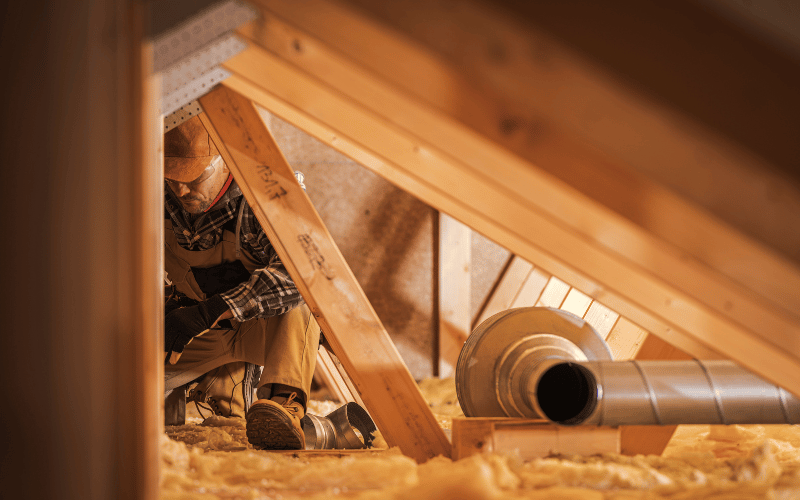When considering the installation of a central air system in a house without existing ductwork, understanding the potential costs associated with replacing ductwork in your attic is crucial. With Energy HVAC Services, you’re not just getting a service – you’re partnering with a team of seasoned professionals dedicated to delivering efficient and effective solutions tailored to your specific needs. We provide transparent and competitive quotes, ensuring you understand every aspect of the financial commitment involved. With Energy HVAC Services, you’re investing in enhanced comfort, increased property value, and peace of mind. Contact us today for a consultation – let us navigate this journey with you.
The HVAC system, often unseen but always felt, is the unsung hero of our home comfort. It works tirelessly behind the scenes to keep our homes at the perfect temperature, no matter the season. A crucial component of any HVAC system is the ductwork, which serves as the circulatory system, distributing air throughout the house. In many homes, ductwork is tucked away in the attic, out of sight and mind. However, it’s essential to ensure its proper functioning and replacement when necessary.
Understanding Your Ductwork
Installing ductwork for AC, central air, or an entire HVAC system requires careful planning and precise execution. Understanding the purpose and operation of your home’s ductwork is essential to maintaining your HVAC system’s efficiency and longevity. Let’s delve a bit deeper into this important topic.
Role of Ductwork in HVAC Systems
The ductwork in your home serves as a conduit for conditioned air. Whether you’re running the heating or cooling function of your HVAC system, the conditioned air is distributed through these ducts to various parts of your home. When installing ductwork for AC or central air, the goal is to create an efficient pathway for air flow, ensuring uniform temperature distribution across all rooms.

Replacing Ductwork
Materials Used in Ductwork
There are several types of materials used in HVAC ductwork, each with its own advantages and potential issues:
- Metal Ducts: These are usually made from galvanized steel or aluminum. They are durable, non-flammable, and highly resistant to many types of damage, making them a popular choice for many homeowners and contractors. However, they can sometimes be subject to rust if exposed to moisture.
- Flexible Ducts: Made from a wire coil covered by a bendable, durable plastic, and surrounded by insulation, flexible ducts are useful for navigating around obstacles where rigid ducts may not be suitable.
- Fiberglass Duct Board: This type of ductwork is constructed from compressed fiberglass boards. It has the advantage of providing built-in thermal insulation, reducing heat loss or gain from the conditioned air moving through the ducts.
Common Ductwork Issues
Several common issues might necessitate replacing ductwork in the attic, basement, or walls. Some of these include:
- Leaking Ducts: Over time, the seals between duct segments can deteriorate and cause leaks, leading to a loss of efficiency in heating or cooling.
- Poor Design: If ductwork was poorly designed or installed, it might not deliver air efficiently to all areas of your home, leading to hot or cold spots.
- Age-Related Wear and Tear: Like all parts of a home, ductwork ages and can become less effective over time. Corrosion, physical damage, or insulation deterioration can all signal that duct replacement is necessary.
Understanding your ductwork can help you identify potential issues before they become more serious problems. It can also help you communicate more effectively with HVAC professionals, like those at Energy HVAC Services, who can assist with replacing ductwork in your attic, basement, or wal
The Process of Replacing Ductwork in the Attic
The task of replacing ductwork in attic spaces poses unique challenges compared to installing ductwork in a basement or running ductwork in walls. Here’s the typical process:
- Inspection: First, a thorough inspection is conducted to assess the extent of the damage or inefficiency and decide whether replacement is necessary.
- Removing Old Ductwork: Next, the old ductwork is carefully removed to avoid causing damage to your home or the HVAC system.
- Installing New Ductwork: New ductwork is then installed, ensuring it’s well insulated and properly sealed to maximize efficiency.
- Testing: Finally, the system is tested to confirm it’s operating correctly
While these steps might seem straightforward, they require a significant amount of skill and expertise, making professional installation crucial.
Costs Involved in Replacing Ductwork in the Attic
Replacing ductwork in attic spaces is a substantial investment, with costs influenced by various factors. Here’s a breakdown:
- Material Costs: The cost of the materials will vary depending on the type of ductwork you choose. Metal ducts, although durable and long-lasting, tend to be the most expensive. Flexible ducts, made from a wire coil covered by bendable, durable plastic and surrounded by insulation, are generally less costly but might not last as long. Fiberglass duct board offers built-in thermal insulation and can be a cost-effective choice.
- Labor Costs: Labor costs form a significant portion of your total expense when replacing ductwork. The process of removing old ducts, installing new ones, and ensuring everything is properly sealed and insulated is labor-intensive and requires expertise. Factors influencing labor costs include the complexity of the ductwork system, local labor rates, and whether there are challenges related to access and working conditions in the attic.
- Size and Complexity of System: The larger and more complex your ductwork system is, the higher the cost of replacement will be. For instance, homes with multiple stories or intricate layouts might have more complex ductwork systems. Similarly, if the ductwork needs to be extended to a new addition or a previously unconditioned space, the cost will increase.
- Home Modifications: If substantial modifications to your home are required to accommodate the new ductwork, these costs will also need to be factored in. This could include cutting into walls, ceilings, or floors, and subsequently repairing them.
- System Testing: Following the replacement of ductwork, the HVAC system installation will need to be tested to ensure that it’s working correctly and efficiently. There may be costs associated with this testing process, including potential adjustments or fine-tuning.
- Additional Costs: You may encounter additional costs for things like custom fittings, insulation materials, and sealing products. Also, if your home needs a new furnace, AC, or an entirely new HVAC system, these costs will significantly add to your total expenditure.
All these factors together comprise the total cost when replacing ductwork in an attic. While the expense can be substantial, it’s crucial to remember that well-maintained and efficient ductwork is a long-term investment in your home’s comfort, air quality, and energy efficiency. At Energy HVAC Services, we strive to provide fair, transparent pricing and top-notch service to make this process as smooth and affordable as possible for our customers.
Tips for Maintaining Your Ductwork
Maintaining your ductwork can extend its lifespan and prevent premature replacement costs:
- Regular Inspections: Schedule regular inspections to catch issues early before they become significant problems.
- Cleaning and Maintenance: Keep your ducts clean and free of debris to prevent blockages and improve air quality.
- Professional Help: If you notice any issues, don’t hesitate to call in professional help. Early intervention can save you time and money in the long run.
Choosing the Right HVAC Service Provider
Choosing the right HVAC service provider is a critical decision that can significantly impact the efficiency, lifespan, and overall performance of your HVAC system. Here are some factors to consider when making this choice:
- Experience and Expertise: Ensure the company has experience in handling projects similar to yours. A provider like Energy HVAC Services, with a track record of successfully installing ductwork for AC and central air, replacing ductwork in attics, basements, or running ductwork through walls, is a good option.
- Certifications and Licenses: Confirm that the company has the necessary certifications and licenses. These accreditations provide evidence of the company’s adherence to industry standards and regulations.
- References and Reviews: Check for references and reviews from past customers. Reliable providers will have positive feedback and will be more than willing to share references.
- Transparency: Choose a company that provides clear and detailed estimates, explaining the cost of replacing ductwork in the attic, basement, or elsewhere, including both labor and material costs.
- Availability: Find out about the company’s availability and response time. You want a provider who can respond promptly to your needs, especially in case of emergencies.
- Comprehensive Services: Look for a provider that offers a range of services, including installation, repair, and maintenance. This will ensure that you can turn to them for future needs.
- Warranties and Guarantees: An HVAC service provider confident in their work will offer warranties and guarantees on their services. This provides you with protection and peace of mind.
- Customer Service: Good customer service is key. From the first contact to the completion of the job, they should communicate clearly, listen to your concerns, and be willing to answer your questions.
By keeping these points in mind, you can find a reliable HVAC service provider that meets your needs, such as Energy HVAC Services. Our commitment to quality, transparency, and customer satisfaction sets us apart in the industry.
Conclusion
While the cost of replacing ductwork in the attic or installing ductwork for AC may seem daunting, it’s crucial to remember the benefits it brings. Efficient ductwork saves you money in energy costs, increases your home’s value, and, most importantly, keeps your home comfortable. Trust Energy HVAC Services to guide you through the process and deliver excellent service.
Frequently Asked Questions
Are attic ductwork replacements generally more expensive than other locations?
Yes, attic ductwork replacements can be more expensive due to the challenging access and often extreme conditions in attics. The need for additional insulation and protective measures, given temperature fluctuations in attics, can also drive up costs compared to other locations.
What additional costs might be involved in attic ductwork replacement?
Additional costs in attic ductwork replacement might include improved insulation, addressing any mold or moisture issues, and potential structural adjustments for proper fit. Safety equipment or specialized tools for attic conditions might also factor into the cost.





